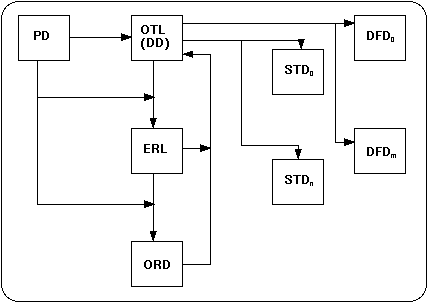Knowbotic Interface Project
Constructing a conceptual model
This
is a working paper which will probably be rewritten several times in the next months
AUTHOR: Dr. Gerd Döben-Henisch
COLLABORATORS: Leo Pos und Thore Swindall
FIRST DATE: December 27, 1995
DATE of LAST CHANGE: March-25, 1996
For KIP II we adopted ideas outlined in RUMBAUGH et al. (RUMBAUGH 1993) and ELLIS (ELLIS 1994:237ff) (for a short historical discussion of other approaches see Transforming Reality into a symbolic Representation.
For the construction of a conceptual model [CM] we distinguish the following individual steps thereby presupposing a problem space (PD) (cf. the figure below) :
- Construct an OBJECT TEMPLATE LIST (OTL) based on the problem description PD. An OT as an element of an OTL consists in the beginning only of the name of an object. Later on this will be enriched with all the details, which are necessary, to give a full description of an object or an class. In the completed version represents the OTL the DATA DICTIONARY (DD) of the project.
- Construct an EVENT-RESPONSE LIST (ERL) following the OTL and the PD. This has to be done for every distinguished object-pair. Transform such a list in an EVENT-PATH DIAGRAM (EPD). Enhance OTL if possible.
- Construct an OBJECT RELATIONSHIP DIAGRAM (ORD) based on PD, OTL, and ERL. This has to be done with graphical symbols! Enhance OTL if possible.
- For every object from OTL construct a STATE TRANSITION DIAGRAM (STD) -including parallel processes-. Use formal graphical symbols. Enhance OTL if possible.
- For every method of every object construct an DATA FLOW DIAGRAM (DFD). Use graphical symbols. Enhance OTL if possible.
- Make TESTs with the material so far at hand. If there are features lacking or there occur unwanted effects rework (1) - (5).

Continue with Implementation Requests.
Comments are welcomed to kip-ml@inm.de

Daimlerstrasse 32, 60314 Frankfurt am Main, Deutschland. Tel +49- (0)69-941963-0,
Tel-Gerd: +49(0)69-941963-10


